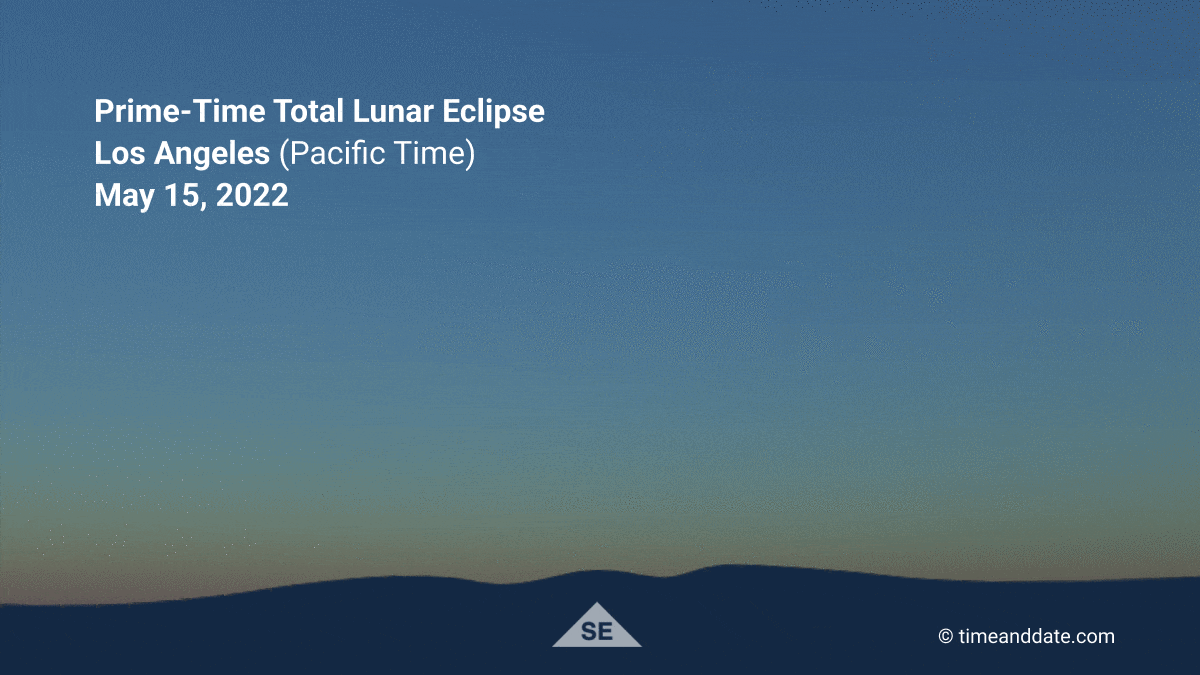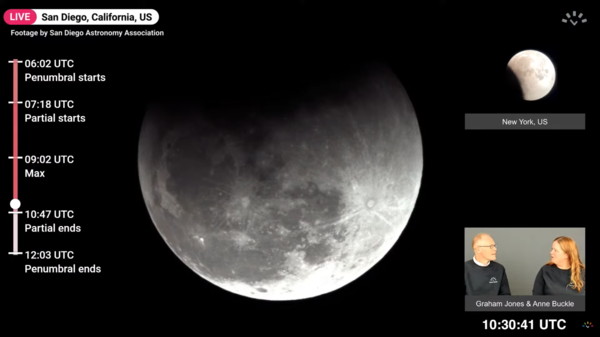Longest Prime-Time Totality on the West Coast This Century
The next lunar eclipse will be a Sunday-evening spectacular in North America.

How an eclipsed moonrise will appear in Los Angeles on May 15, 2022.
©timeanddate
Prime-Time Totality
During the lunar eclipse of May 15–16, 2022, about 1 hour and 25 minutes of totality will be visible (weather permitting) from across the 48 contiguous United States.
Totality is the period where the Full Moon is completely covered by the dark part of Earth’s shadow, and turns a reddish color.
For Pacific and Mountain Time Zones, totality will be a prime-time Sunday evening event: it will run from around 8:29 pm to 9:53 pm PDT/MST, and 9:29 pm to 10:53 pm MDT.
Longest of the 21st Century
We searched our data for the longest prime-time totalities in the USA this century.
In the world of television, prime time refers to the peak viewing period between 8 pm and 11 pm. So, at timeanddate, we came up with a definition of a prime-time eclipse: it’s where totality begins after 8 pm local time, and finishes before 11 pm local time.
For residents of the Pacific Time Zone—which includes California, Washington, and parts of Idaho, Nevada, and Oregon—May 2022 turns out to be the longest prime-time totality of the 21st century.
This is also the case for most of Arizona (which, uniquely among US states in the Mountain Time Zone, mostly does not use Daylight Saving Time).
Eclipse Timings for May 15–16, 2022
A lunar eclipse plays out hundreds of thousands of miles away, as Earth’s shadow crosses the face of the Moon. Observers on the nighttime side of Earth see the same events happening at the same moment.
Nevertheless, because observers are spread out across different time zones, local times for the eclipse vary.
| Los Angeles | Denver | Chicago | New York | São Paulo | London | |
|---|---|---|---|---|---|---|
| PDT | MDT | CDT | EDT | BRT | BST | |
| Start of partial | 7:40 pm (moonrise) | 8:27 pm | 9:27 pm | 10:27 pm | 11:27 pm | 3:27 am |
| Start of totality | 8:29 pm | 9:29 pm | 10:29 pm | 11:29 pm | 12:29 am | 4:29 am |
| End of totality | 9:53 pm | 10:53 pm | 11:53 pm | 12:53 am | 1:53 am | 5:10 am (moonset) |
| End of partial | 10:55 pm | 11:55 pm | 12:55 am | 1:55 am | 2:55 am | --- |
Check eclipse times for your city
A Family Event
Anne Buckle and Graham Jones, the hosts of timeanddate’s eclipse live shows, say the timing of the eclipse makes it a family event for observers in the western half of North America.
“Normally, prime time for astronomers begins after astronomical twilight, when the Sun has sunk way below the horizon,” says Graham. “Astronomical prime time is also regarded as being when there’s no Moon around to interfere with the darkness of the sky.”
Adds Anne: “However, for a lunar eclipse, we have no hesitation in saying that prime time is when the Full Moon is low in the sky, soon after sunset. It’s a perfect opportunity for the whole family to go outside and see the Sun-Earth-Moon system at work.”

Anne Buckle and Graham Jones seen here hosting a timeanddate live show in November 2021.
©timeanddate
The Most Balanced Pair of Eclipses for 430 Years
The May 15–16 event will be the first of two total lunar eclipses in 2022. The second will occur on November 7–8.
The length of totality for each of these eclipses is almost identical: 1 hour 24 minutes 50 seconds in May, and 1 hour 24 minutes 54 seconds in November.
According to our data at timeanddate, this will be the most balanced pair of total lunar eclipses within the same calendar year in over four centuries. (In the 430-year period from 1661 until 2091, there is no other year that contains two total lunar eclipses of such equal length.)
Next, Solar Eclipses Take Center Stage
Following the total lunar eclipses of 2022, our attention will turn to solar eclipses.
- In April 2023, a total eclipse will touch the edge of Western Australia.
- Six months later, in October 2023, an annular eclipse will sweep across the USA, Mexico, Central America, Colombia, and Brazil.
- Another six months after that, in April 2024, a total eclipse will cross Mexico, the USA, and Canada.
As always, timeanddate will be covering all the above eclipses LIVE.